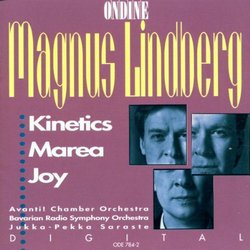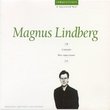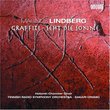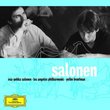| All Artists: Magnus Lindberg, Jukka-Pekka Saraste, Avanti! Chamber Orchestra, Bavarian Radio Symphony Orchestra Title: Magnus Lindberg: Kinetics (1988-89) / Marea (1989-90) / Joy (1989-90) - Jukka-Pekka Saraste Members Wishing: 0 Total Copies: 0 Label: Ondine Release Date: 2/1/1995 Genre: Classical Styles: Chamber Music, Instruments, Electronic, Symphonies Number of Discs: 1 SwapaCD Credits: 1 UPC: 761195078426 |
Search - Magnus Lindberg, Jukka-Pekka Saraste, Avanti! Chamber Orchestra :: Magnus Lindberg: Kinetics (1988-89) / Marea (1989-90) / Joy (1989-90) - Jukka-Pekka Saraste
CD DetailsSimilar CDs |
CD ReviewsThe genesis of Lindberg's mature style Christopher Culver | 01/30/2005 (4 out of 5 stars) "This Ondine disc collects a "trilogy" of works which inaugurated Lindberg's second phase of composition, which has continued until today and and has made him one of the most consistently fascinating of contemporary composers. With its complicated harmonies and endless invention, it's a whole new world of music, and well-worth picking up.
The style of Lindberg's youth was squarely avant-garde and it culminated in 1985's "Kraft", a massive work (the score is nearly a meter tall) of titanic forces using not only traditional instrumentation, but also lots of clinking and clanking on scrap metal and spoken word. The result, though conceptually interesting, shows music out of control where its disparate parts (up to seventy harmonies at once!) are not closely intergrated. He then produced a piece called "Ur" which marked the end of this method. After a hiatus of over two years, Lindberg returned with this trilogy "Kinetics"-"Marea"-"Joy", where his new compositional technique has him building giant networks of harmonies but keeping them all meticulously managed and interrelated. This is the style that has sustained him to the present moment, and in it he has created some true masterpieces of modern-classical music, such as "Feria", "Cantigas", and his "Cello Concerto". Lindberg's comeback piece "Kinetics" (1988-1989) is the most notable piece on the disc. A work for a large symphony orchestra, it consists of two levels of harmonies, in which the softer "background" contains chords founded on the notes missing from the "foreground". The piece uses the largest ensemble of the three works here. I can't say much about it, except that I think this is tremendously exciting, lots of noisy relentless activity that is nonetheless held together by a scheme of progression. Not since Boulez's orchestration of "Notations II" has there been such a colourful that bangin' work that offers a great depth of analysis but which nonetheless is instantly enjoyable by a generation raised on rock and electronica. "Marea" (1989-1990), scored for a "Beethoven-sized" orchestra, is titled by the Italian word for "tide". Indeed, the mechanics of the work are wave-like, and the feature which shows Lindberg evolving in this new fresh style is an "anchoring" of the harmony on certain points which bring the work a little out of modernism into neo-romanticism. Furthermore, Lindberg tries every couple of years to create a genuinely slow-moving piece (think of "Corrente" or "Parada"), and while he's using buzzing with amazing ideas to bring it off, this attempt is a bit more successful than others. The seeming slowness of the work combined with its (relatively!) simple harmonic structure means that the work will probably be favoured by the listeners who cannot handle the frenetic buzz of "Kinetics" or the long exposition of "Joy". The use of brass percussion at the end (I think it resembles a hyperactive Sofia Gubaidulina) is thrilling. "Joy" (1989-1990) was commisioned by Ensemble InterContemporain and realised at IRCAM. The step in Lindberg's compositional prowess displayed here is a third layer, the timbral aspect of harmony. As one might expect from the high-tech setting, it uses live electronics, in this case a sampler (whose source material comes from the demolition of an old grand piano with a sledgehammer!) and a synthesizer. The synthetic sounds fit in well with the traditional instrumentation, though the composer has chosen to not use synthesizer after this piece. At 26 minutes, "Joy" is by over ten minutes longer than the other two works on the disc; it is quite meditative and calmly displays its ideas. I find it to be less exciting than the other two pieces here, though I understand how it was a key part of Lindberg's growth. If you have never heard Magnus Lindberg's work before, I'd point you to the Sony disc with "Cantigas" and three other pieces conducted by Lindberg's old school chum Esa-Pekka Salonen, or to the Onine disc with "Feria-Corrente II-Arena" conducted as here by Saraste. Those two show him in this same style but fully mature, and are good entry points. This triptych, however, is the foundation of all of his work of the last 15+ years, and is worth getting soon in your exploration of this ever-impressive artist." |


 Track Listings (3) - Disc #1
Track Listings (3) - Disc #1


